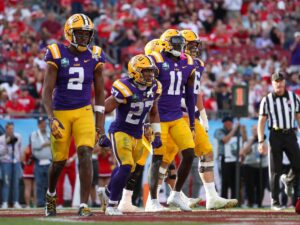
Utah Utes Land Former Auburn 4-Star Recruit, Bolstering Big 12 Aspirations
In a significant move that underscores the evolving landscape of college football player movement, the Utah Utes have secured a commitment from former Auburn Tigers four-star recruit, Jahki Howard. The addition of the highly-touted freshman wing is a notable victory for the Utes and their head coach, Alex Jensen, as they look to build a competitive program in the newly expanded Big 12 Conference. Howard, a 6-foot-6 standout from Boston, Massachusetts, was a prized prospect in the 2024 recruiting class, ranked as the No. 19 small forward and the No. 64 overall player nationally by 247Sports. His decision to transfer to Utah after limited playing time at Auburn highlights the increasing prevalence and impact of the NCAA transfer portal.
Howard’s journey to the Big 12 began with high expectations on The Plains. As a four-star recruit, he was anticipated to contribute to an Auburn team that ultimately reached the Final Four in the 2024-2025 season. However, the freshman found it challenging to carve out a significant role on a veteran-laden roster. This lack of consistent playing time prompted his decision to explore other opportunities through the transfer portal, a mechanism that has become increasingly influential in shaping college basketball rosters across the country. The portal allows student-athletes to seek new programs where they might find a better fit, more playing time, or a different coaching style.
For the Utah Utes, the acquisition of a player with Howard’s pedigree is a significant statement. The program is entering a new era under the leadership of Alex Jensen, a former Utah player who brings a wealth of experience from his time as an assistant coach in the NBA, most recently with the Dallas Mavericks, where he helped the team reach the Western Conference Finals. Jensen’s appointment marks his first head coaching role at the college level, and landing a high-potential talent like Howard signals the program’s ambition to compete in the Big 12.
The Big 12 Conference itself is undergoing a transformation, with the recent additions of Utah, Arizona, Arizona State, and Colorado further solidifying its status as a major power conference in college athletics. As these new members integrate into the league, the competition is expected to intensify, making the recruitment and retention of talented players even more critical. Howard’s commitment represents a crucial building block for Utah as they navigate this new landscape.
Howard’s skillset and potential are undeniable. As a highly-ranked small forward, he possesses a combination of athleticism, versatility, and scoring ability that could make him a valuable asset for the Utes. While his playing time at Auburn was limited, his talent was evident in the opportunities he did receive. His ability to impact the game on both ends of the floor aligns with Coach Jensen’s vision for the program.
The transfer portal has become a double-edged sword for college programs. While it offers opportunities to add talented players who may be seeking a fresh start, it also presents the challenge of roster management and the potential for significant turnover. Programs must now navigate the complexities of recruiting both high school prospects and transfer student-athletes, balancing immediate needs with long-term development. Auburn’s experience of losing a four-star recruit like Howard underscores this reality. Despite the loss, Auburn has been active in the transfer portal themselves, bringing in several high-profile transfers and maintaining a strong recruiting class, indicating their proactive approach to roster building in the portal era.
The impact of the transfer portal extends beyond individual player movement and team rosters. It has also influenced coaching strategies and recruiting philosophies. Coaches must now be adept at evaluating transfer prospects and integrating them into their existing systems quickly. The ability to identify players who not only possess talent but also fit the program’s culture and academic standards is paramount. Furthermore, the rise of Name, Image, and Likeness (NIL) opportunities has added another layer of complexity to the transfer process, as athletes may consider potential financial benefits when making their decisions.
Utah’s successful recruitment of Jahki Howard can be seen as a testament to Coach Jensen’s ability to connect with and attract high-level talent. It also speaks to the appeal of the Big 12 Conference and the opportunities that lie ahead for the Utes as they embark on this new chapter. Howard’s commitment has generated considerable excitement among Utah fans and provides a significant boost to the program’s momentum heading into the 2025-2026 season.
As the college basketball landscape continues to evolve, the transfer portal will undoubtedly remain a central element of roster construction. Programs that can effectively navigate its complexities, identify the right fits, and build a cohesive team culture will be best positioned for success. Utah’s addition of Jahki Howard is a promising sign that they are ready to embrace this new era and compete at a high level in the Big 12 Conference. The blend of Howard’s potential and Coach Jensen’s leadership creates an intriguing dynamic that could lead to significant progress for the Utes in the seasons to come.





